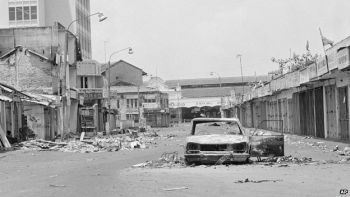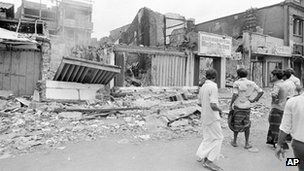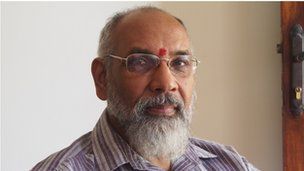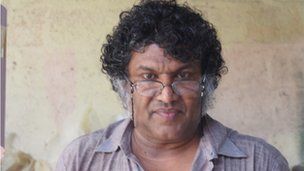
Publisher:
Bonnie King
CONTACT:
Newsroom@Salem-news.com
Advertising:
Adsales@Salem-news.com

~Truth~
~Justice~
~Peace~
TJP
Jul-27-2013 00:05

 TweetFollow @OregonNews
TweetFollow @OregonNews
Remembering Sri Lanka's Black July
Charles Haviland The BBC"There was a first mob of about 80-odd young guys with iron rods and things. They were in a frenzy, obviously under the influence of alcohol - they smashed up and then came the next lot to loot." - elderly woman
 The mob violence that erupted after an attack on 13 soldiers triggered a 26-year civil war |
(COLOMBO, Sri Lanka) - Thirty years ago, Tamil separatists stepping up militant attacks in northern Sri Lanka and killed 13 soldiers. Over the next few days, mobs of the Sinhalese majority took revenge, killing between 400 and 3,000 Tamils around the country and triggering a civil war that lasted 26 years and sent hundreds of thousands of Tamils into exile. The BBC's Charles Haviland reports on the legacy of what came to be known as Black July.
In the stillness of a Colombo afternoon, as a clock chimes three, an elderly woman looks back 30 years and remembers.
"There was a first mob of about 80-odd young guys with iron rods and things. They were in a frenzy, obviously under the influence of alcohol - they smashed up and then came the next lot to loot."
Priya Balachandran - the BBC has changed her name as she prefers anonymity - recalls the time Colombo and much of southern Sri Lanka seemed gripped by madness. Mob violence was wrought on people, most of whom had little idea what was happening in the north.
Like other Tamils, Ms Balachandran was on the receiving end. Sharing lunch with her mother, son and a Sinhalese neighbour, she saw shops ablaze over the road and realised the mob were approaching. Quickly, the friend suggested escaping to her own place just 300m (984ft) up the road until things calmed down. They left Ms Balachandran's house.
"Little did we realise that that was the last time we were running out of our home," she recalled, her voice cracking with emotion.
From the friend's house, she could hear her home being looted by the gangs who had detailed records of which dwelling was Sinhalese and which was Tamil.
"We could hear the sounds as if they were breaking up in the room next door. In a matter of an hour or so, we could see thick black smoke.
"That was really traumatic for me and my child and the family. We had to just keep praying through it - then by evening, late into the evening again, a second time, they came and burnt it down, the final bits."
When asked what was destroyed, Ms Balachandran said: "The whole thing. There was nothing. It didn't seem like our home any more. It was just black, that's all I remember."
Ms Balachandran said she and her family, like so many others, were saved by their Sinhalese neighbours.
But other Sinhalese were murdering, rooting out Tamils by showing them objects and demanding to know the Sinhala word. A young Sinhalese artist, Chandraguptha Thenuwara, recalls his bus being stopped.
"I could hear sounds coming from the back of the bus, they are taking a person out from the bus," he said.
"They identified him as Tamil. So then the bus moved forward and they took him down. I don't know what happened to him."
Later he would walk through a city, much of which was ablaze.
 Shops set ablase in down town Colombo |
Little sympathy
People were burned alive in their cars, stripped naked. Women were raped. In Colombo and provincial towns, soldiers stood by and even supplied petrol. In two pogroms in the biggest prison, Sinhalese inmates killed 53 of their Tamil counterparts.
There was almost certainly government complicity - a Sri Lankan human rights group says gangs operated at the behest of hard-line ministers.
On 27 July 1983, the then President JR Jayewardene made his first speech on the events, offering no sympathy to the minority and instead emphasising Sinhala grievances.
More killings followed. By the time the violence dwindled on 31 July 1983, tens of thousands of Tamils had fled to the northern and eastern provinces or abroad.
 Mr Wigneswaran said a lot of intellectuals left |
Black July was a recruiting agent for Tamil militants and catapulted the country into full-blown war, which would last 26 years and kill 100,000 or more people.
It had a drastic demographic effect as hundreds of thousands of Tamils fled abroad, said CV Wigneswaran, a retired Supreme Court judge who has just become a politician for the largest Tamil party.
"With that started the brain drain. A lot of intellectuals, lawyers, doctors, architects, engineers all went away from Sri Lanka. They thought there was no way out," he said.
"The diaspora today still cannot forget the death, damage, destruction that took place in 1983 because of which they had to leave Sri Lanka and go abroad."
The idea of a separate Tamil homeland - then as now illegal as a political platform - also became more powerful because so many Tamils fled to the areas of the island where they were the majority.
The retired judge said that ever since 1983, many Tamils have not felt comfortable living in southern Sri Lanka, with the exception of the capital.
Nationalist assault
Four years after the government's war victory, it says there are "no minorities" and everyone is equal.
Yet Sinhalese nationalist sentiment and speeches are on the upsurge. There remains nervousness, not only among Tamils, but also among another minority, the Muslims, who have seen their mosques attacked and their lifestyle under sustained assault from Sinhalese Buddhist nationalists, including monks.
With the Tigers crushed in 2009 and unknown numbers of Tamil civilians killed as the war ended, hard-line ministers now advocate reducing devolution for the Tamil areas despite a constitutional clause that is meant to increase it.
In 2004, the previous President Chandrika Kumaratunga gave a public apology to Tamils for Black July, likening it to Nazism.
 Mr Thenuwara says the country has not properly |
She appointed a commission which concluded that nearly 1,000 people died and 700,000 were exiled. And she acknowledged there might be many more unreported incidents.
In his studio, the artist Chandraguptha Thenuwara is preparing artwork and sculptures for an exhibition he now mounts every year to commemorate Black July and reflect the current state of justice.
Despite Mrs Kumaratunga's gestures, no one has been held accountable for the July killings, and Mr Thenuwara said the country has not properly faced up to past wrongdoings.
"That kind of attitude is not good for the resolution of these kind of issues," he said.
"Reconciliation cannot happen. You have to speak and talk about it. Even the bad things happened. You have to open up the wound and to heal this real way."
In her modern-day home Priya Balachandran, who saw her house burnt down, shows me treasured family photo albums. They were salvaged by a friend who pretended to be a looter on those mad July days.
She still has many good Sinhalese friends, and I ask her how she feels now about ethnic relations.
"Hopefully, nothing is going to happen again," she said. "That's what we feel because I think that was a lesson which all sides have learnt.
"The war of 30 years has taught both sides equally, I think. They have gone through enough suffering."
 |
 |
 |
Articles for July 26, 2013 | Articles for July 27, 2013 | Articles for July 28, 2013

googlec507860f6901db00.html
Salem-News.com:



Terms of Service | Privacy Policy
All comments and messages are approved by people and self promotional links or unacceptable comments are denied.
[Return to Top]
©2025 Salem-News.com. All opinions expressed in this article are those of the author and do not necessarily reflect those of Salem-News.com.